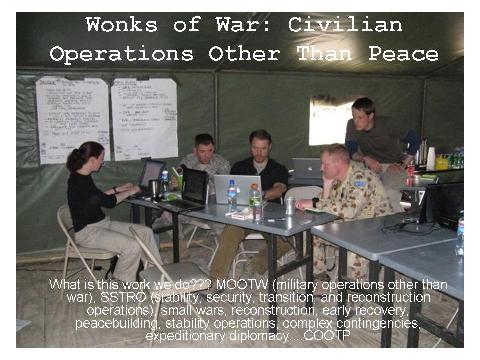April 22, 2010
by: Laura A. Hall
Note: This is adapted from remarks given at the book launch for U.S. Peacefare. Audio of the full event including remarks by the author Amb. Dane Smith, former USAID Deputy Administrator Jim Kunder, and LtGen John Sattler (USMC ret) as well as Q&A is available here.
With the publication of his book, Ambassador Dane Smith has compiled the first and most comprehensive account of the US perspective’s on the recent history of international peacebuilding. Having spent the last six years at the Department of State’s Office of the Coordinator for Reconstruction and Stabilization (S/CRS) and the NSC, I would like to build onto the book’s recommendations.
- Lead Agency Model: It is appropriate and important that interagency coordination be vested in a “lead agency” and that it be the Department of State.
 The Secretary of State needs to maintain responsibility for foreign policy direction. In drafting the NSPD-44, there was little debate that the Secretary of State needed to maintain responsibility for foreign policy direction including for coordinating across civ-mil lines. State’s having a leadership role does not suggest collecting all the operational parts of State, USAID, and the interagency into one office that would take over and run post-conflict operations. Having State in a lead role on policy and coordination and developing more operational and expeditionary diplomats is not a threat to USAID’s responsibilities.
The Secretary of State needs to maintain responsibility for foreign policy direction. In drafting the NSPD-44, there was little debate that the Secretary of State needed to maintain responsibility for foreign policy direction including for coordinating across civ-mil lines. State’s having a leadership role does not suggest collecting all the operational parts of State, USAID, and the interagency into one office that would take over and run post-conflict operations. Having State in a lead role on policy and coordination and developing more operational and expeditionary diplomats is not a threat to USAID’s responsibilities.
From a management perspective a consolidation would be a disaster. It would separate personnel from one another across somewhat fuzzy boundaries between crisis response and conflict prevention and between early recovery and long term development. The personnel would also lose the benefits of being part of larger organizations with broad responsibilities which provides much of the advantages of calling on the larger US government capabilities. In addition, policy makers would never agree on criteria for shifting responsibility from the steady-state actors (regional bureaus and embassies) to the crisis response actors. The process of transferring policy and operational responsibility would be severely handicapped by bureaucratic turf battles.
- Elevate and empower the NSC: To ensure effective processes, the NSC must take responsibility for directing interagency decision making.
In the deliberations about how to meet the need for crisis response, NSC leadership was clear that the NSC should not become operational. However, there is a need for greater authority and responsibility than is currently provided.
The past and current position of Director of Stability Operations is one person, buried within the org chart, who gets minimal attention and support from above. The NSC should be providing direction and guidance on contingency planning priorities, demanding better planning products, enforcing decision making, and insisting on integrated efforts. A higher level position for the lead officer on stability operations, additional staff who can support regional directorates in their planning efforts, and a coherent NSC structure connecting development, humanitarian response, stability operations, international organization affairs, and defense would improve the ability of the NSC to exercise these responsibilities. A greater role doesn’t mean doing all of the planning and taking responsibility away from line departments. Doing so would decrease the responsibility they would feel and leave the NSC conducting planning in a vacuum.
- Decision Making, Planning, and Integration: Recognize the importance of effective processes and the need for management arrangements, personnel, and doctrine.
There remains a deficiency in the policy community’s understanding of what is needed for more effective operations. Most critics focus on the need for greater civilian capacity for deployments and that need is in no dispute. S/CRS has made progress in this endeavor. However, one of the primary reasons behind the creation of S/CRS was to address the need for better management and organization of complex operations. Managing complex operations requires identifying clear responsibilities for integration of efforts (civ-mil, interagency, and international), providing support to decision making processes, and coordinating planning and execution of operations.
 These are not typical functions and require different kinds of personnel who are trained and can apply lessons learned from other operations, who are prepared and available to immediately start supporting the Regional bureau and Embassy decision makers in planning processes and setting up staffing. It also requires a common operating “doctrine” that guides the process so that the many moving parts know how to work together. This coordination function requires something more than meetings to de-conflict efforts and it cannot be done in an ad hoc manner. Complex operations require something more formalized, based in lessons-learned, to be effective. Even a special envoy, which can be useful in many circumstances, needs a staff and eventually must develop more standardized processes. (more…)
These are not typical functions and require different kinds of personnel who are trained and can apply lessons learned from other operations, who are prepared and available to immediately start supporting the Regional bureau and Embassy decision makers in planning processes and setting up staffing. It also requires a common operating “doctrine” that guides the process so that the many moving parts know how to work together. This coordination function requires something more than meetings to de-conflict efforts and it cannot be done in an ad hoc manner. Complex operations require something more formalized, based in lessons-learned, to be effective. Even a special envoy, which can be useful in many circumstances, needs a staff and eventually must develop more standardized processes. (more…)

No comments:
Post a Comment